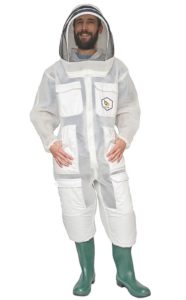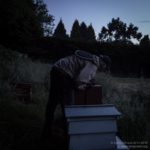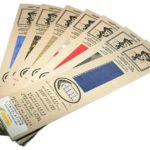Keeping your cool
Beekeepers sweat, men perspire and women glow, or something pretty close to that, was an adage that originated in a Victorian etiquette guide {{1}}.
And, in the weather we’ve been enjoying recently, it’s not far from the truth.

Only mad dogs and Englishmen … and beekeepers
Beekeeping in hot weather
Even here on the East coast of Scotland we’ve had some long, hot and sunny days {{2}}. It’s been perfect picnic weather, it’s made for a great Spring honey crop and it’s been purgatory doing colony inspections.
The first one or two are fine, but I soon warm up. After half a dozen hives, particularly when shifting nectar-laden supers off and on, or setting up double-boxed splits, it starts to get uncomfortable. An hour or so later and it’s really grim {{3}}.
And it’s worse in the bee shed. The shelter and warmth that are so valuable on days with rubbish weather or at the extremes of the season, work against you in the heat of the summer. The temperature inside the shed regularly exceeds 30°C and, with no air movement, it can be stifling.
What’s the best way to cope with the heat?
Beesuits

BBwear Ultra suit
Most of the major manufacturers make lightweight beesuits. I’ve got one from BBwear made from some sort of Teflon coated material. It’s certainly lightweight – about half the weight of my standard poly/cotton suit – but is saved for use when working in Varroa and disease-free areas. The relatively rare hot days we have don’t really justifying buying (yet) another full suit.
BBwear have recently introduced their Ultra suit made from a ‘high tec fully ventilated 3D fabric’. At £359 (eke! {{4}}) I’m unlikely to ever get to wear one {{5}}, but I’d be very interested to hear of anyone who has experience of it.
For quick inspections a jacket is cooler than a full suit … but during quick inspections you’re unlikely to work up much of a lather.
The clothing you wear under the beesuit also has a big influence – shorts and a T-shirt are much better than jeans and a fleece.
And if you need to wear a fleece under your beesuit to provide protection against stings it’s time to requeen the colony.
Timing is everything
Inspecting colonies under the heat of the midday sun can be hard work. If time permits you could always inspect earlier or later in the day, or time your visit to the apiary so that the hives are in dappled shade rather than full sun.
Work commitments mean I often have to conduct inspections late in the afternoon. On hot days it is usually cooler by 5pm, but by the time I’ve got round most of the colonies it can be getting quite late {{6}}.
Of course, as the day cools the hive fills with bees, making the important observation of the comb more difficult. This is compounded by fading light levels.
Given the choice – and I’m usually not – I’d probably prefer to inspect in mid-morning, once the bees are up and out, but without having to worry about running out of daylight or time.
The “You cannot be serious” {{7}} option

John McEnroe c.1979
A headband is a very effective way to stop the sweat getting in your eyes, dripping off the end of your nose and splashing onto the inside of the veil. You might associate headbands (sweatbands) with tennis players or Mark Knopfler from Dire Straits, but they are just as much use to overheating beekeepers. Just remember to retrieve it from the pocket of your beesuit at the end of the afternoon, rather than leave it festering in there until the inspections the following week … a damp and slightly fetid headband not only doesn’t look good, it also doesn’t smell good.
But it’s still very effective.
If you want to get ahead, get a hat {{8}}
The near-ubiquitous baseball cap provides almost as much perspiration-protection as the headband and probably has a little more sartorial elegance (not difficult). They have the added advantage that, on windy days, the peak prevents the veil blowing against your face at precisely the same time the one aggressive bee in the colony decides to make a kamikaze attack.
Baseball caps work well under the ‘fencing veil’ hoods, but I cannot comment on their suitability for the wire-framed ‘retro’ hoods as these fit more closely to the crown (and I’ve never used one).
G’day, cobber {{9}}
Cobber Enterprises (disappeared from the web, but still recommended) make a neck scarf filled with water-absorbing gel granules. You soak it in water for ~15-25 minutes and wear it loosely tied around your neck (no surprises there). It works by evaporative cooling of the carotid arteries. I’ve had a couple of these for years {{10}} and have used them when walking in Southern Spain or Mallorca … and beekeeping. They need to be next to your skin and should be rotated periodically to find another cool patch.
They are extremely effective.
When writing this post I looked up the current pricing and availability of a Cobber. I was horrified to see they’re now over £20. However, you can dry them out and reuse them time and again. Mine appear to work as well now as they did when I got them about 15 years ago {{11}}.
In Australia they’re about £7 🙁 {{12}}
Drinking on the job
The beekeeping veil provides protection to keep any bad tempered bees from your sensitive lips, tongue and eyes. However, it doesn’t prevent you rehydrating as required … you can simply guzzle water from a bottle directly through the veil. This works very well and is very refreshing on a long hot afternoon in the apiary.
However, stick to water only and avoid sticky, sugary drinks for obvious reasons. Drinking hot tea through the veil is possible, but not really recommended … not least because its ability to cool you be inducing sweating is probably negated by the fact you’re at least ‘glowing’ already.
And finally, once the inspections are all finished and the beesuit is hanging up (or destined for the washing machine), it’s time for a cuppa … or a ‘purely medicinal’ ice-cold beer 😉
Colophon
Of course, writing an article on good weather and beekeeping will more or less guarantee the rest of the summer is a wash-out. Sorry.
I should add that “other beesuit suppliers are available”. I list BBwear as they’re the only suits I’m familiar with … I’ve bought about a dozen over the last decade for home or work and never seen the need to change.
{{1}}: It’s actually horses that sweat in the original.
{{2}}: As I write this, yesterday – the day before this post appears – is predicted to be 25°C, with sunrise at 4.26 and sunset at 22.05.
{{3}}: As an amateur beekeeper this is when I realise just how physically demanding commercial beefarming must be.
{{4}}: Beekeeping pun.
{{5}}: It also looks a bit sterile and space-age to me … I’d imagine that propolis stains down the front and a big blue blotch in the pocket from a leaky Posca pen would rather spoil the effect.
{{6}}: On cool days it can get distinctly chilly, to the point when I often have to postpone inspections to another day.
{{7}}: John McEnroe uttered this during a first round match at Wimbledon against Tom Gullikson in 1981, and followed it with a tirade of ill-tempered invective.
{{8}}: This was an advertising phrase from Dunn & Co., a ‘gentleman outfitter’, from the 1940’s
{{9}}: Cobber is an archaic Australian colloquialism for ‘mate’ … it became heavily overused and is probably more likely to be heard by people trying to (poorly) imitate Australians these days.
{{10}}: Not because I have two heads … I lost one and bought another, then – no surprises here – found the original.
{{11}}: For appreciably less than £20.
{{12}}: Get a friend from there to send you one … they weigh just a few grams and fit in a standard envelope (when dry).


Join the discussion ...